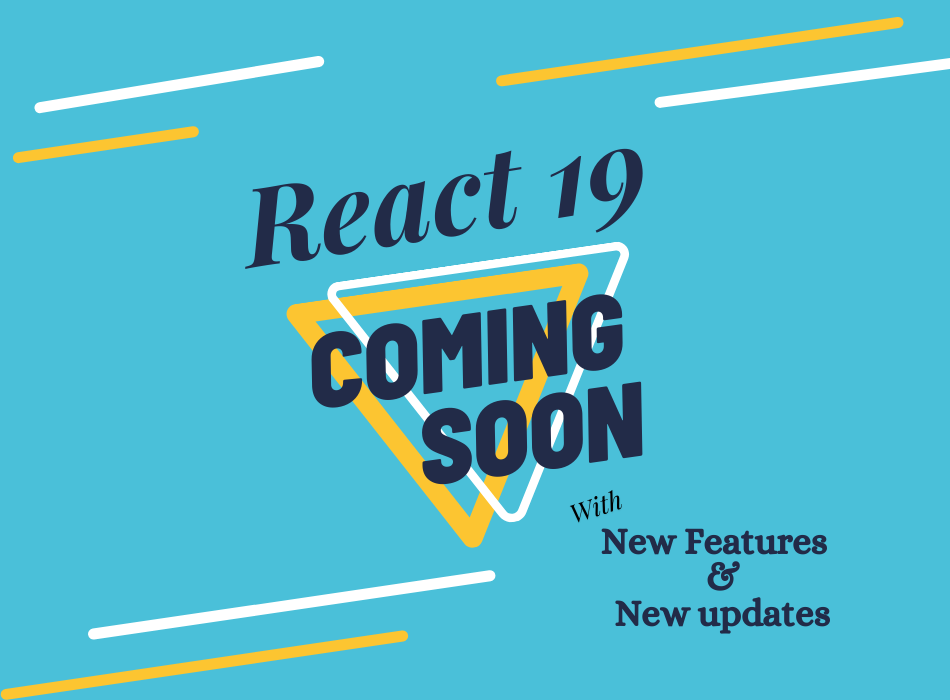Introduction React 19 :
World of web development, React has been a foundation for building naturally and responsive user interfacing. With each emphasis, React propels to meet the demands of show day web change. The desire for React 19 has been discernable among engineers around the world. In this web diary post, we plunge into the release date, highlights, upgrades, and give a comprehensive direct on how to redesign to React 19.
React 19 Release Date
React 19, the latest version of Meta’s JavaScript library for rendering user interfaces has officially landed on npm and is now available in beta for every developer, The official release date for React 19 has been announced yet. However, the Release Candidate (RC) version was made available on April 25, 2024. Typically, the full release happens shortly after the RC, so it’s likely that React 19 will be fully released soon.
In any case, it's basic to note that release dates are subject to change based on the advancement development and any unforeseen challenges experienced by the React team.
The release date for React 19 is still in development, but it is expected to be formally compelled either by the conclusion of 2024 or at the starting of 2025. Keep an eye on the official React channels for announcements and updates.
Presently React 18.2.0 is running Everyone knows that React 19 will be released but when it will be released is not yet known so react.dev team official released on April 25, 2024 in which the official update about React 19 and the New features coming in React 19.0
React 19 Features
React 19 comes stuffed with a few energizing highlights pointed at updating execution, design experience, and flexibility. A few of the striking highlights include:
Concurrent Rendering: React 19 presents advancements in concurrent rendering, allowing for smoother user experiences, especially in complex applications with overpowering rendering tasks.
Built-in State Management: With React 19, engineers can utilize built-in state organization capabilities, streamlining the plan of supervising application state and diminishing the require for exterior libraries.
Improved Server-Side Rendering (SSR): React 19 moves forward SSR capabilities, driving to faster initial page loads and made strides in SEO execution for server-rendered applications.
Enhanced DevTools: The most recent frame of React ships with overhauled creator devices, giving more encounters into component life cycles, execution optimizations, and exploring capabilities.
Improved Error Handling: React 19 presents improvements in bumble taking care of components, making it easier for originators to analyze and troubleshoot botches in the midst of progression and production.
React 19 Updates:
Stay tuned for development updates and declarations with regard to React 19. The React bunch is committed to passing on a relentless and feature-rich release, and redesigns will be shared by means of official channels, checking the React web journal, GitHub store, and community forums.
React 19 new hooks
React 19 Beta is now available on npm!
React 19 beta introduces a couple of new hooks focused on improving how you manage application state, specifically related to data fetching and forms. Here's a breakdown of the two main hooks:
useOptimistic: This hook allows you to implement optimistic UI updates. In essence, you can update the UI based on the assumption that a data update will be successful, even before you receive confirmation from the server. This can provide a smoother user experience by reflecting changes immediately
useActionState (along with useFormStatus): These hooks are introduced in conjunction with a new concept called "Actions". Actions are essentially functions that manage common data fetching patterns, including features like pending state, optimistic updates, and error handling. useActionState helps manage the state of these Actions, while useFormStatus is specifically designed to work with form-related Actions.
UseOptimistic
The new useOptimistic hook in React 19 beta allows you to implement optimistic UI updates while data is being fetched asynchronously. This means you can update the UI to reflect the assumed outcome of the action even before you get confirmation from the server. This can significantly improve the user experience by providing a quicker response and smoother interaction.
Here's a breakdown of how useOptimistic works:
-
Input: It takes the current state of your application as input.
-
Output: It returns a copy of the state that can be modified during the asynchronous operation.
-
Optimistic Update Function: You provide a function that defines the optimistic update logic. This function receives the current state and any additional input related to the action being performed. It then returns the "optimistic" state that you want to display while waiting for the server response.
Benefits:
-
Improved User Experience: Provides a more responsive and fluid experience for users by reflecting changes immediately.
-
Simpler Code: Helps manage the logic of updating the UI based on the action's outcome in a centralized location.
import { useOptimistic } from 'react';
function MyComponent() {
const [count, setCount] = useState(0);
const incrementOptimistically = useOptimistic(count, (currentCount) => {
return currentCount + 1; // Optimistic update: assume increment is successful
});
const handleIncrement = async () => {
try {
const response = await fetch('/api/increment'); // Simulate asynchronous API call
const data = await response.json();
setCount(data.count); // Update state with actual data from server
} catch (error) {
console.error('Error incrementing count:', error);
// Revert optimistic update if necessary (implementation details might differ)
}
};
return (
<div>
<p>Current Count: {incrementOptimistically}</p>
<button onClick={handleIncrement}>Increment</button>
</div>
);
}
React DOM: <form> Action
new concept called <form> Actions specifically designed to simplify form handling. Here's how to prepare a React DOM <form> using Actions in React 19 beta:
You'll need to import a couple of functions from react-dom:
JavaScript
import { useFormActions } from 'react-dom';
Create the form and Action function:
-
Define your form using JSX with the input fields and submit button.
-
Create a separate function (let's call it handleSubmit) that will handle the form submission logic, including making the API call or performing any other necessary actions.
React DOM: Use Form states
Here's a breakdown of useFormState:
-
Purpose: This hook helps manage the state of your form based on the results of form actions. It essentially eliminates the need to manually update state using functions like useState after form submission.
-
Functionality:
-
Action: This is a function that encapsulates the logic for handling form submissions. The action function typically performs tasks like data validation, API calls, and potentially updating the server. It receives the current form state and any additional arguments passed during form submission as input.
-
InitialState: This defines the initial state of your form data.
-
Current State: This reflects the current state of your form data. During the initial render, it will match the provided initialState. After a form submission (assuming the action function updates the state), the current state will reflect the updated values.
-
Form Action: This is a new action function specifically designed to be used with your form component. You can pass this function as a prop to your form component or a form button to trigger form submission.
-
-
Input: It takes two arguments:
-
Output: It returns an array containing two elements:
React 19 beta introduces two key features related to server-side rendering:
-
Server Components (RSC):
-
Server Components are a new way to define components that can be rendered on the server before being sent to the client. This can improve initial page load performance, especially for complex applications.
-
RSCs are written in JavaScript using standard React syntax but leverage a special directive (use server) to indicate they should be executed on the server.
-
They have access to server-side functionality, like fetching data before the component is sent to the client.
-
RSCs can be integrated with existing client-side React components, offering a flexible approach to server-side rendering.
-
Server Actions:
-
Server Actions are functions defined within Server Components. These functions can be triggered from client-side components to perform server-side operations like data fetching or form validation.
-
Server Actions are triggered using a special directive (use client) within the Server Component.
-
The results of Server Actions can be passed back to the client-side component as props, allowing for seamless integration with the client-side application state.
Upgrading to React 19 requires cautious organizing and thought, especially for wanders with existing codebases. Here's a step-by-step coordinate to offer help you effortlessly move to
Review React 19 Documentation: A few time as of late proceeding with the overhaul, through and through review the React 19 documentation to get it the unused highlights, API changes, and potential breaking changes that may influence your application.
Check Compatibility: Assess the compatibility of your existing codebase with React 19. Recognize any regretted APIs or highlights that require to be updated or supplanted to ensure compatibility.
Update Dependencies: Update your project's conditions, tallying React, ReactDOM, and other related libraries, to the most later adjustments steady with React 19.
Test Thoroughly: Conduct comprehensive testing of your application after the upgrade to recognize any backslides, execution issues, or compatibility issues displayed by the present day adjustment of React.
Address Dissuaded APIs: Address any regretted APIs or highlights in your codebase by supplanting them with proposed choices given by React 19.
Optimize Performance: Take advantage of unused highlights and execution optimizations promoted by React 19 to update the by and large execution and responsiveness of your application.
Deploy Incrementally: Consider sending the upgraded shape of your application incrementally to direct dangers and ensure a smooth move for end-users.
Monitor and Debug: Persistently screen your application post-upgrade for any issues or botches, and utilize exploring disobedience to analyze and resolve any issues that may arise.
By enlisting in our React 19 online preparing, you'll be well-equipped to:
-
Build high-performance web applications that provide a predominant user experience.
-
Develop and keep up complex React applications with ease and efficiency.
-
Stay ahead of the curve with the most recent React advancements.
-
Impress potential employers with your mastery of React 19.



